What is a SCOBY?
Kombucha SCOBYs are symbiotic colonies of bacteria and yeast that work together to ferment sweet tea into the tangy, probiotic-rich drink we love. The gelatinous structure of the SCOBY, the pellicile, is a polysaccharide matrix, primarily built by Acetobacter bacteria. These bacteria secrete the compounds that give it its firm, rubbery texture. All pellicles are SCOBYs, but not all SCOBYs make a pellicle. While the pellicle is a recognizable sign of a healthy fermentation, the SCOBY resides in the floating cellulose layer AND the liquid kombucha. So when you ask, “What is a SCOBY?”—the honest answer lies in the microbes that create and sustain it. Let’s look at the microorganisms that make up this living colony.
A healthy kombucha culture typically includes Pediococcus, Saccharomyces, and Acetobacter species, each playing a role in fermentation, acidity, and carbonation. Many SCOBYs also house microbes from the Zygosaccharomyces, Schizosaccharomyces, and Komagataeibacter genera, contributing to fermentation and flavor complexity. Some SCOBYs even contain Lactococcus, Leuconostoc, and Lactobacillus species, though these typically comprise only a tiny portion of the microbial community. Each kombucha batch has its unique microbial fingerprint, shaped by the environment and fermentation conditions, making every brew a little different. (reference articles linked below recipe card)
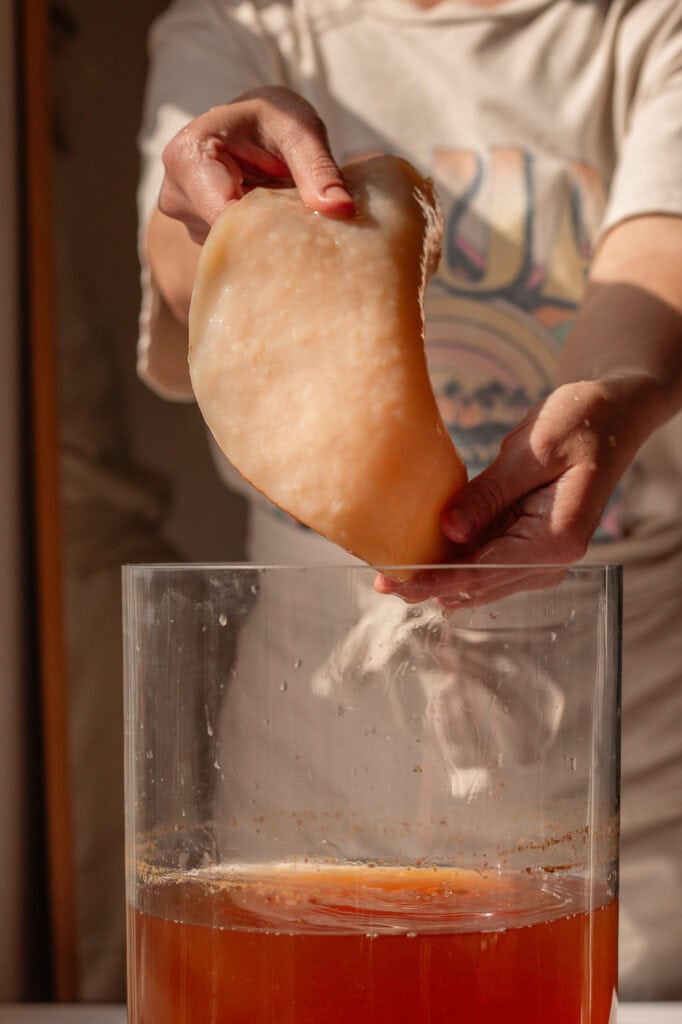
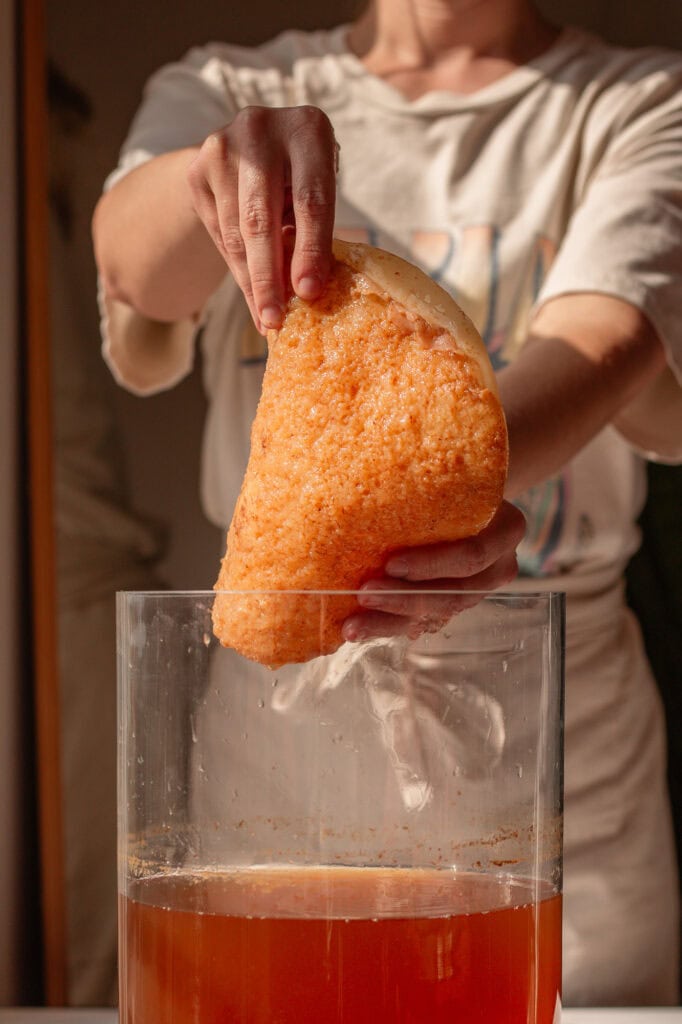

How to Make a Kombucha SCOBY
With just a little patience and the right starter, you can grow a kombucha SCOBY from store-bought kombucha. When choosing a kombucha for this process, look for a raw, neutral flavored variety with plenty of stringy floaties or sediment at the bottom of the bottle—these are the living microbes that will help form your new SCOBY. I like GTs trilogy or honey crisp apple for more neutral flavor options.
Before starting, drink most of the kombucha, but reserve at least ¼ cup and keep as much sediment as possible. This concentrated liquid contains the beneficial bacteria and yeast needed to seed a new SCOBY.
Next, brew a batch of sweet tea starter liquid (recipe below). Once it has cooled to room temperature, pour the reserved kombucha and its sediment into a clean jar, then fill the rest of the jar with the cooled sweet tea. Cover it with a breathable cloth lid, secure it with a rubber band, and let it ferment undisturbed for 7 to 14 days. Over time, you’ll see a new SCOBY forming on the surface—a sign that your homemade kombucha culture is coming to life!
You can also buy a kombucha starter culture to grow a SCOBY and begin brewing your kombucha.
Click here to learn about the best tea for kombucha
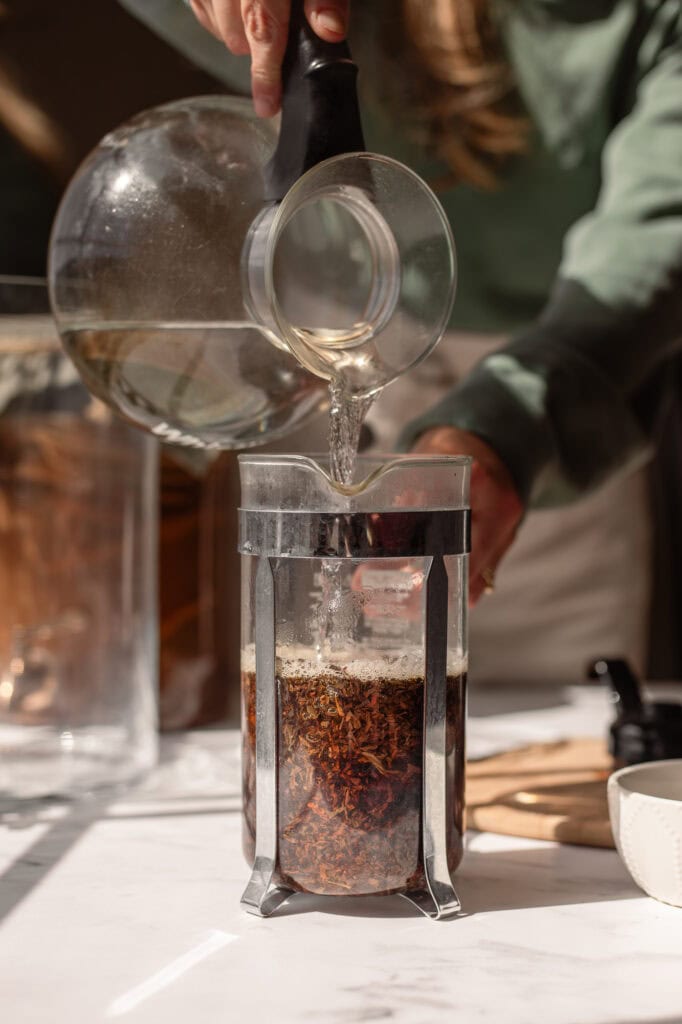

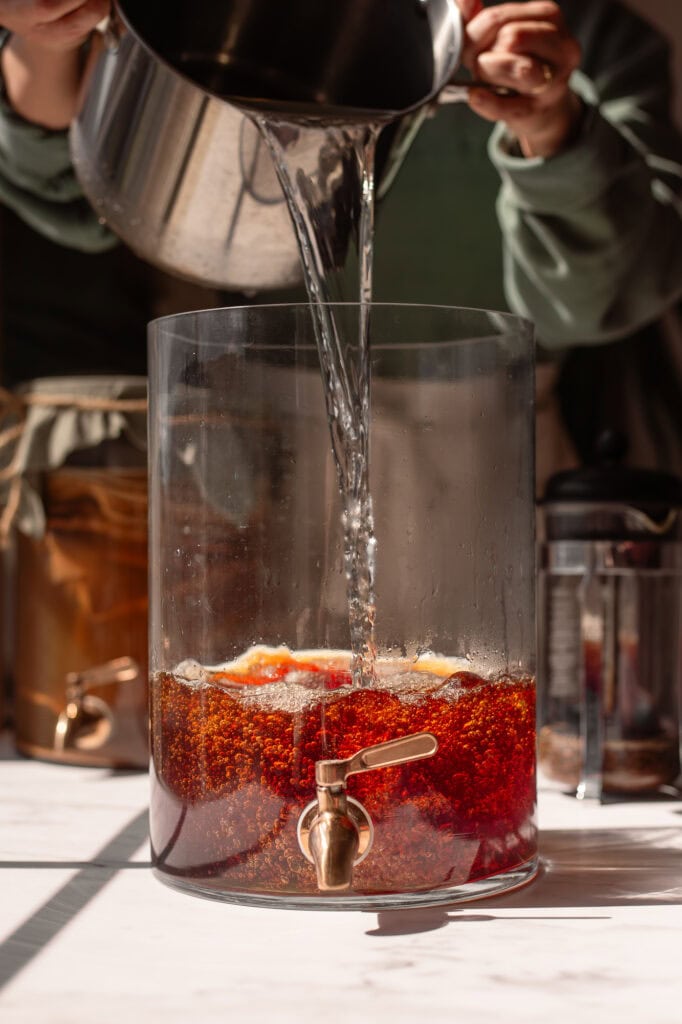
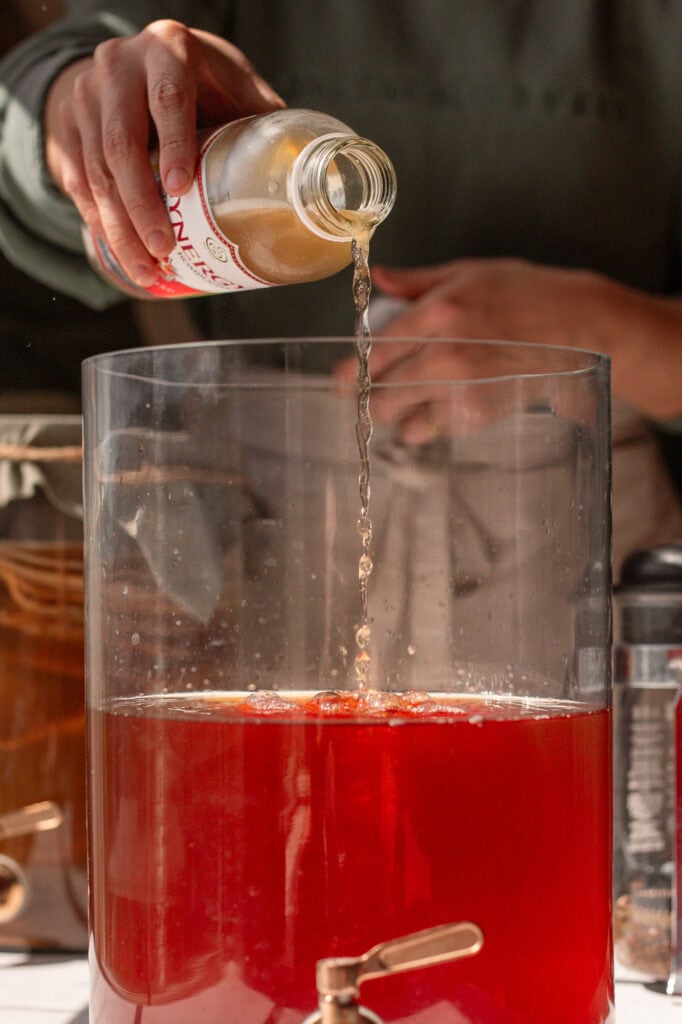
What is a SCOBY and How Should It Look?
At first, you’ll notice a thin, transparent film forming on the surface of the sweet tea. This is the early stage of SCOBY formation, so try not to disturb it; it needs time to develop. As the days go by, the film will gradually thicken and become more opaque, shifting to an off-white or light brown color. The texture should be smooth and shiny, though its exact color may vary depending on the type of tea used.
Within 12-30 days, your SCOBY should be fully formed. It may start as a thin patchy layer, but don’t worry, it will grow as you brew more kombucha. Most mature SCOBYs reach a thickness of about ½ to 1 inch, though size can vary depending on fermentation conditions. Each batch helps strengthen the culture, so even a delicate SCOBY can become more robust over time!
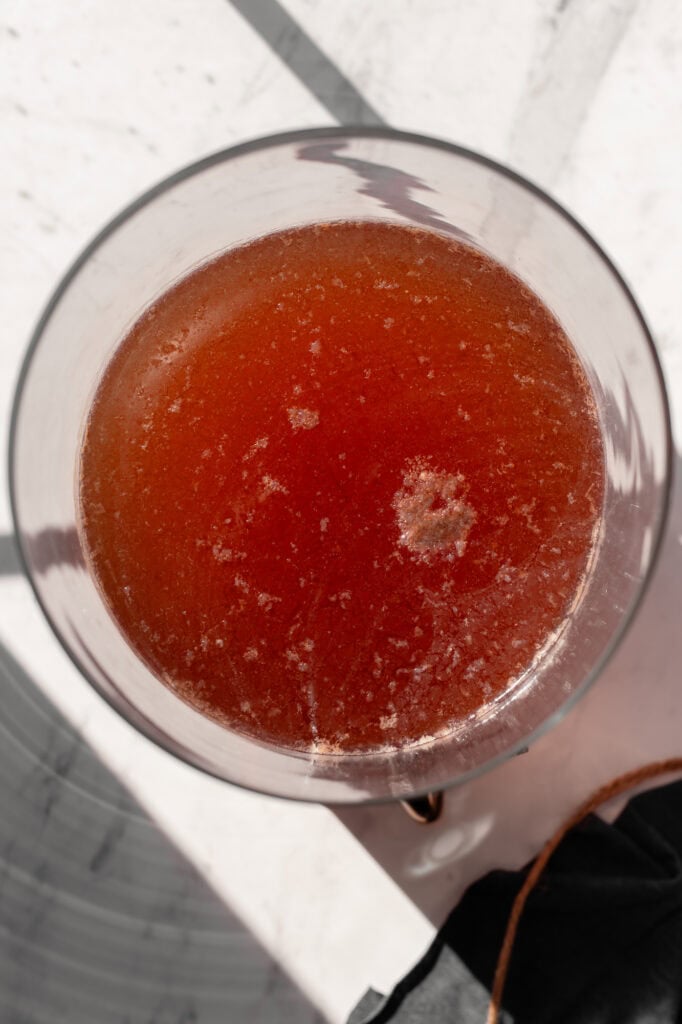
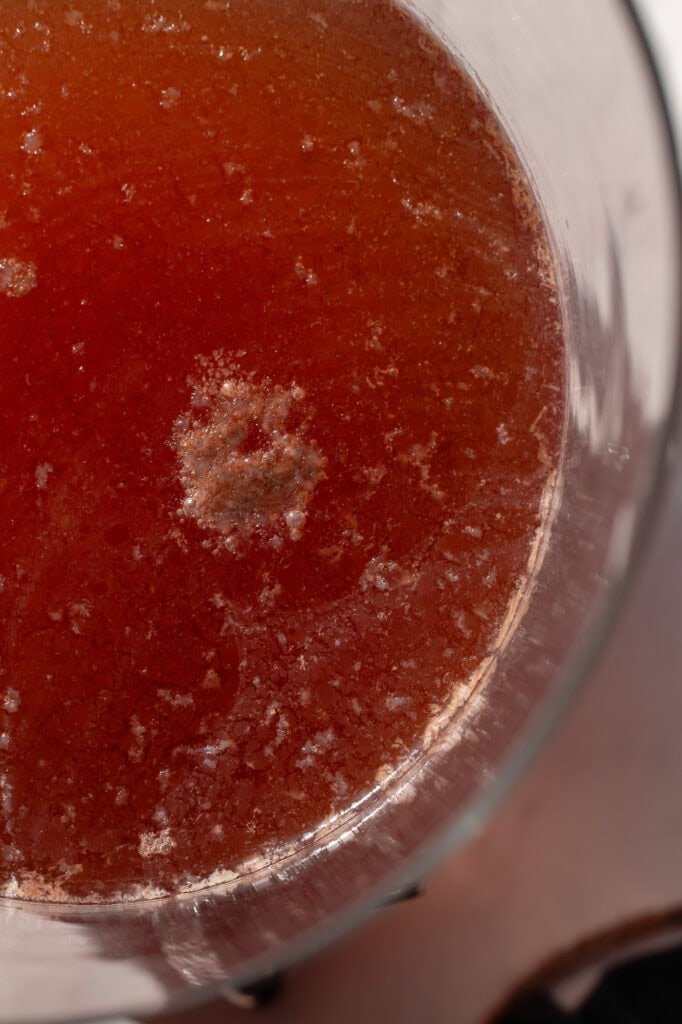
Pictured above is about three days after adding some store-bought kombucha to freshly brewed sweet tea. Below is about four days later. You can see that the carbonation from the store bought kombucha caused some bubbles in the SCOBY.
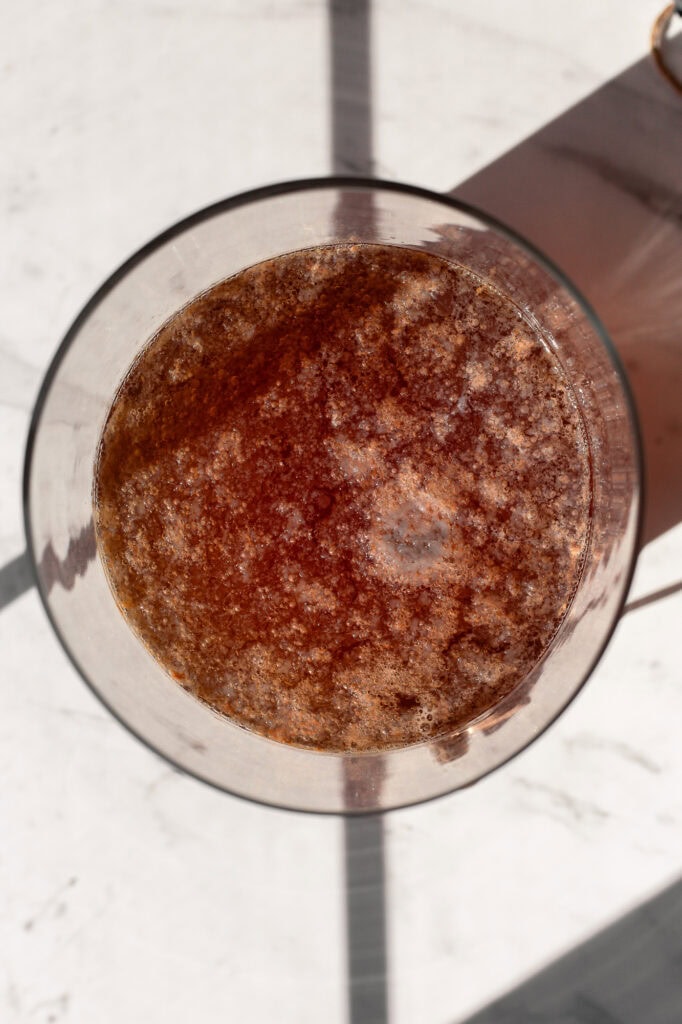
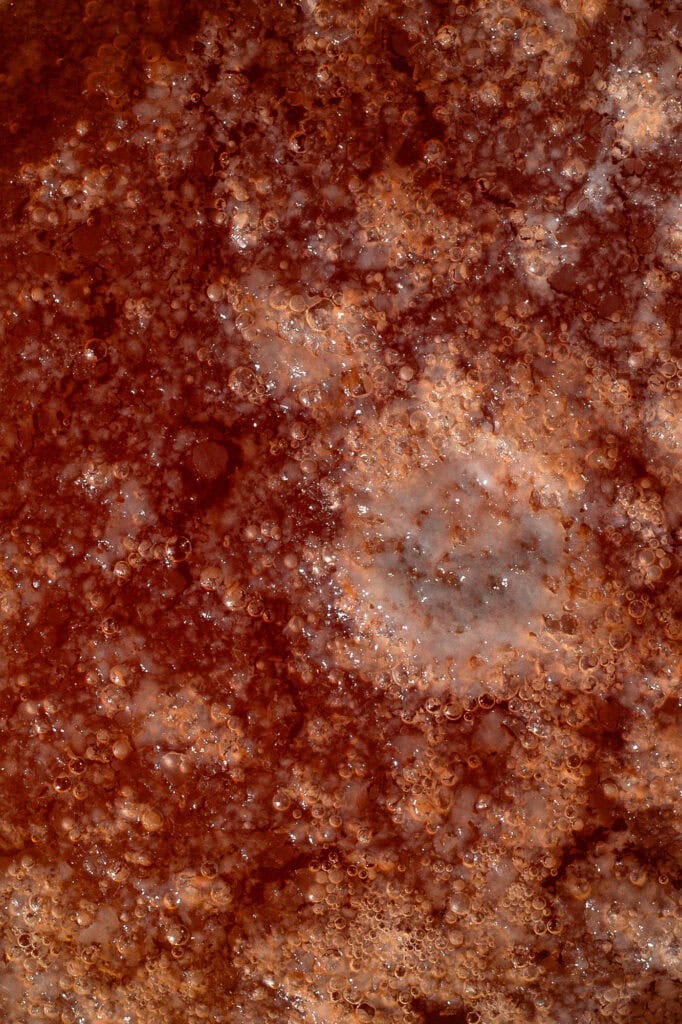
How to Store a SCOBY
Each time you brew a fresh kombucha, a new SCOBY will form on top of the liquid. The original SCOBY, now called the “mother,” will be at the bottom, while the newly formed “baby” will be at the top. Over time, you may end up with multiple layers in your fermentation jar. Right now, I have four stacked in mine, all working together to ferment sweet tea into kombucha.
If you find yourself with extra SCOBYs, they’re great to share with friends, start new batches, or even sell—some people list them on Etsy! If you’re not ready to use them right away, you can also store extras in the fridge in a SCOBY hotel to keep them preserved until you need them.
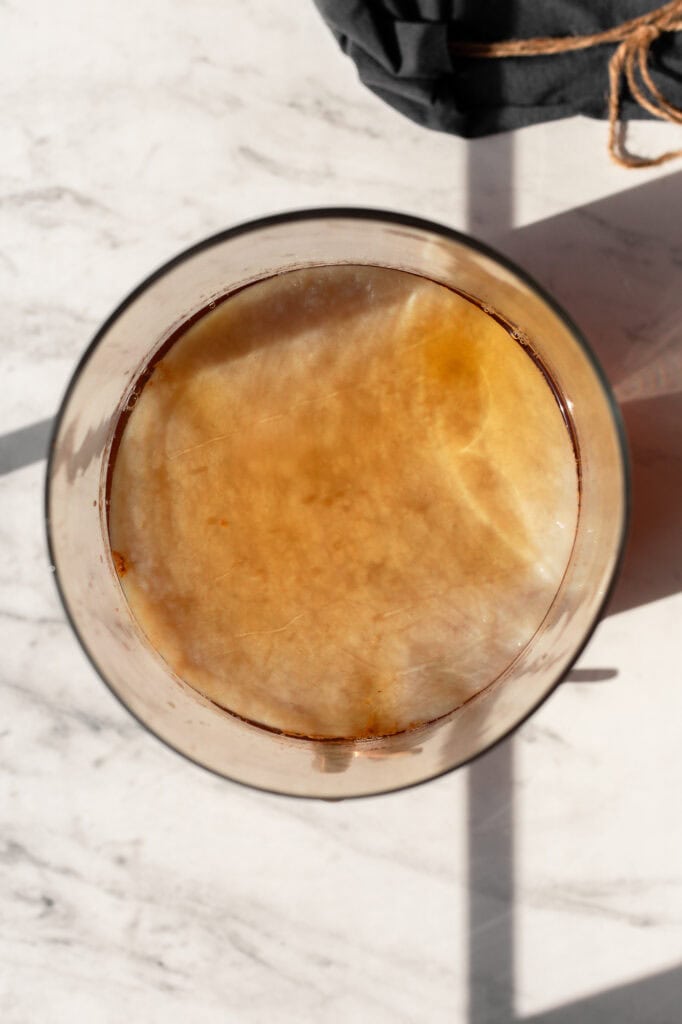

What is a SCOBY Hotel
If you brew kombucha often, you’ll quickly accumulate extra SCOBYs. So, what’s the best way to store them? The answer is a SCOBY hotel—a simple way to keep extras healthy and ready for future batches.
Setting up a SCOBY hotel is effortless. Start by placing all your extra SCOBYs in a large, clean jar. Then, brew a fresh sweet tea and let it cool to room temperature before pouring it over the SCOBYs.
Cover the jar with a breathable cloth lid secured with a rubber band, then store it in a cool spot. Unlike active brewing, a SCOBY hotel doesn’t need frequent attention—feed it fresh sweet tea every four weeks to keep the culture thriving while cutting down on maintenance.

Can Kombucha Grow Mold?
Many people worry about accidentally growing mold, and that’s a valid concern. While kombucha can grow mold, it’s rare and easily preventable with proper sanitation and fermentation conditions.
The most common cause of mold in kombucha is unsanitary equipment. To avoid contamination, thoroughly clean your fermentation jars, utensils, cloth covers and hands before handling your SCOBY.
A healthy SCOBY should be off-white to light caramel in color. If you ever see fuzzy blue, green, white, black, or gray spots forming on the surface of the SCOBY or the sides of the jar, that’s mold—and unfortunately, it means the batch is unsafe. Mold spores spread throughout the liquid, so scraping it off won’t fix the issue. If mold appears, discard everything and start fresh.
To ensure a safe fermentation, you can test the pH of your kombucha during primary fermentation using pH strips. A properly fermented batch should have a pH between 2.7 and 3.7 after about 12 days of fermentation. It should also smell lightly sweet and pleasantly sour, never musty or rotten.

How to Feed a SCOBY (Primary Fermentation)
Feeding a SCOBY is part of the primary fermentation process in kombucha brewing. It should be fed fresh sweet tea every 12 to 30 days to keep the culture healthy. The timing can vary greatly depending on temperature. Warmer conditions speed up fermentation, while cooler environments slow it down. Most batches are ready to move to secondary fermentation within 7-14 days (I personally think 7 days is too short; but it’s technically fine).
Once the tea has fermented it is ready for secondary fermentation. At this stage, the SCOBY is removed, and the fermented tea is bottled in carbonation-safe bottles along with flavoring, such as fruit juice or herbs. This step allows the kombucha to develop its natural fizz and deeper flavor before it’s ready to drink.
Kombucha Second Fermentation, Flavoring, and Bottling Recipes
- Blood Orange Kombucha with Sage
- Summer Peach and Pomegranate Kombucha
- Rosemary and Grapefruit Kombucha Flavor Recipe

Kombucha Primary Fermentation (how to feed a SCOBY)
Learn how to feed a kombucha SCOBY also known as kombucha primary fermentation.
- Prep: 10 minutes
- Cook: 10 minutes
- Total Time: 20 minutes
Ingredients
- 50 grams organic sugar
- 5 grams organic tea
- 1000 mL water
- 1-liter glass jar
- 1 kombucha SCOBY (or store-bought raw kombucha)*
Instructions
- Gather your ingredients
- Boil your water and dissolve the sugar in the water.
- Steep the tea in the hot water for 5 minutes. If using tea bags, simply remove them. If using loose leaf tea, strain all the tea leaves from the mixture.
- allow the sweet tea mixture to cool completely. It should be room temperature before moving on to the next step.
- Once it is cool, add the kombucha SCOBY. (SCOBY can come from kombucha liquid, or pellicle, or both). Some SCOBYs float, others may sink to the bottom, either way it’s fine. (You can add in store-bought raw kombucha here to grow a SCOBY for the first time).
- Cover the jar with a cloth lid and rubber-band. You must use a cloth lid to allow oxygen flow. Make sure it’s clean and free from lint.
- Keep the jar of sweet tea with the SCOBY at moderate room temperature, out of direct sunlight for seven days. Temperature should be between 65-78 degrees F.
- After 7 days you should notice that your SCOBY is thicker or see another SCOBY forming on the surface. You can let primary fermentation go anywhere from 7-30 days. I recommend ~15 days.
- Make a fresh batch of sweet tea as in the previous directions.
- Remove the SCOBY from the fermented tea and place it in the jar of fresh sweet tea. Set the fermented tea aside for bottling. Add a tablespoon of already fermented tea to the fresh batch.
- The fermented tea is now ready for flavoring and bottling (secondary fermentation)
- For secondary fermentation, you need pressure safe glass bottles and fruit juice for flavoring. I typically fill the bottles half way to 3/4th of the way with fermented sweet tea and the rest with juice.
- Once the bottles are sealed, carbonation builds in the bottles. Secondary fermentation can take anywhere from 5 to 12 days depending on the temperature and amount of juice added.
Notes
- SCOBY can come from kombucha liquid from a previous batch, or a pellicle, or both liquid and a pellicle. You can add in store-bought raw kombucha as the SCOBY, to grow your own SCOBY pellicle for the first time.
- Click here to learn about the best tea for kombucha
Reference
Microbial Composition of SCOBY Starter Cultures Used by Commercial Kombucha Brewers in North America
Microbiology and antimicrobial effects of kombucha, a short overview




















Hi there
My friend gave me a scoby the only thing is I’d like to know if I can use White tea as opposed to green tea & coconut sugar??as I dont use caffeine tea or use the normal cane sugar please can you advise
Kind regards
Lesley
Yes! You can use white tea and coconut sugar. Just be sure all your equipment is clean. Brew the tea with the sugar in boiling hot water to sterilize it first.
Good day from the Philippines. I haven’t found a source yet of kombucha scoby. Is it possible to use the mother from my pineapple vinegar for my kombucha F1? Thanks a lot.
It’s sometimes possible for a vinegar mother to be converted into a SCOBY for kombucha, but it doesn’t always work. You can give it a try though! It may take a few F1 batches before you have any success. Is kombucha sold in stores anywhere in the Philippines? you can grow your own SCOBY from store-bought kombucha.
How do you grow scoby from store brought kombucha?
just add some store-bought kombucha to a batch of primary fermentation mix
Fruit flies got into my jar. The ‘baby’ had some blue mold on it, and a couple of tiny maggots crawling happily on the surface. The mold has now disappeared. I’ve removed the maggots. The ‘baby’ looks fine, a nice pale caramel color. If I hadn’t seen the mold and the maggots, I wouldn’t suspect a thing. Can I make a fresh batch with the ‘mother’ or do I need to trash the whole lot?
Hey there,
You need to discard everything and start over. You should be using a tight-weave cloth lid secured with a tight-fitting rubber band to ensure bugs do not get into the jar. The maggots probably ate the mold and that’s why it disappeared… and there’s likely still mold and fruit fly larvae present in the SCOBY and mixture.
Hello, I love your website. Thank you for all the detailed info.
My question is, if we just do primary fermentation and drink that, does it still have the about the same amount of yeasts and bacteria?
Thank you! and you are welcome!
Yes, the primary fermented sweet tea will have about the same amount of yeast and bacteria as kombucha that goes through two fermentations. If you drink it after primary fermentation it will just taste tart and flat. I personally think the texture and flavor are much better after it gets carbonated in secondary fermentation.
Hi! Thanks for all of this detailed info! If I accidentally covered my primary fermentation jar with a regular lid for 6 days (burped twice, but really not much pressure in the jar) before I realized it, but everything looks okay, can I proceed ahead? Is there any concern in using the scoby or tea?
it’s probably fine. Just make sure your SCOBY gets oxygen through a cloth lid from now on. It needs oxygen to survive.
I’ve been making your kombucha recipes all year (and now some of my own invention). My scoby is huge. Is that a problem or should I get rid of some. Like really big…
Hi! I don’t drink “tea, tea”. I stick to herbal and rooibos. Is it a lost cause for me? Could I make kombucha with rooibos? Thank you!
Contrary to what most people online say, you can make kombucha with herbal tea like rooibos! You may want to feed your kombucha scobys some sweet black tea every now and then to keep them healthy, though.
How can I control the alcohol level during the second fermemtation, for those times when I either do or don’t want it? Occasionally I’d like a hard kombucha for the weekend but most of the time, I don’t want to have any significant residual alcohol.
Hey Kaitlynn!
I have few bottles that just got forgotten and went a bit too far during F1 and F2 as well (very very sour).
Can this kombucha “vinegar” be used to make herbal kombucha vinegar? in most of recipes you would use ACV. Can kombucha pull out also minerals and vitamins from plants as ACV would?
Thank you!
it should work. How well depends on how much sugar was in it before it over-fermented, because that determines how acidic is in it.
Hi Kaitlynn,
Great site, thanks so much for sharing your expertise!
You mentioned that the amount of sugar controls the acidity. If I am finding this a bit too tart as written, would this turn out less tart tasting if I reduced the sugar in the tea for primary fermentation by 10-20%?
I am using minimal additional sugar when I add flavor for the second fermentation but some is unavoidable since I want to add fruit flavor.
Yes! you can reduce the sugar by 10-20% to make it less tart
I read on a fermentation fb group that’s it’s recommended to keep your different ferments at least 6 ft apart so that they don’t cross contaminate. For example, keep your kombucha 6 ft away from your sauerkraut. Do you see this as an issue? I have only a small area for my ferments. Thank you in advance.
Can you use flavored black tea? I am trying to make my own so by and all I have is constant comment black tea. It has orange in it.
you can, but those flavors will be imparted into the SCOBY and all the batches. Note that some teas flavored with artificial ingredients and citrus oils don’t work well because the microbes don’t thrive well with those compounds.
Thank you. I do have a scoby now and I am planning on making my first batch next week. Praying it all works out.
you’re welcome! Let me know if you have any more questions!
I meant to say my own scoby.
Any chance of getting a ginger flavored kombucha recipe?
I’ll add it to my list! We’re going to have a whole month this spring dedicated to creating new fermented drink recipes.
I bought a nice light-colored, shiny surface SCOBY from an online retailer that had a bunch of thumbs up. I put it in a gallon of black tea made from 8 teabags and 1 1/2 cups white sugar. I grow a SCOBY, but it is thin, ugly, lumpy, and thready with a dull grey, dusty appearance. Why the appearance difference? The glass jar is well cleaned and the tea is simmered. Very little chance of contaminates. I bottle in three weeks with a little fresh ginger root in each bottle, and in a week I have a very nice drinkable kombucha that does not make me sick. Should I worry about the ugly SCOBY being a problem?
Did you simmer the sugar too? This does not sound like the recipe I’ve shared here. Non-organic white sugar can cause issues too. If your SCOBY has a dusty or chalky appearance, that is not good, and I don’t recommend drinking it. SCOBYs should be shiny and a uniform color.
I am loving making the different flavored Kombucha. The first batch was so very good but the 2nd batch is very vinegary. I hope that I can brew the vinegary taste out.
You can shorten the primary fermentation time to mellow out the flavor!
Hi! For the scoby hotel, can it live in the fridge or is it in a cabinet?
counter top or cabinet is fine. I keep my on the counter at room temp. Just make sure to feed it occasionally.
Beautiful work, very clean and useful instructions. I’m trying to grow scoby from store bought kombucha and this article reassured that everything is going well. Love from Sicily 🇮🇹
This is Really helpful
Does it have to be an unflavored kombucha from the store? I am having a hard time finding a raw unflavored one.
Let me update this recipe! any neutral flavor works well! GTs trilogy and honey crisp apple are both be great options.
I’ve been making kombuchas from this recipe to great success. I’m looking at putting my primary fermentation into a jar with a spout at the bottom like your scoby hotel – but wondering – do you clean out the jar every time you make a new batch (as I’ve always done – scoby in a bowl for that) or do you just drain the primary fermentation from the bottom and add new tea at the top?
I usually just drain from the bottom and add new tea to the top and give it a slight stir. I sometimes take everything out and clean the whole jar if I feel the sides are looking a little dirty from stuck on SCOBY.
Great!!